实用词汇学论文
词汇学论文
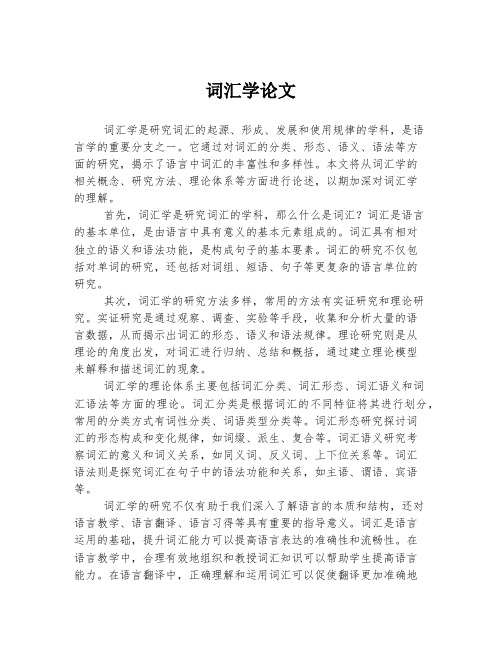
词汇学论文词汇学是研究词汇的起源、形成、发展和使用规律的学科,是语言学的重要分支之一。
它通过对词汇的分类、形态、语义、语法等方面的研究,揭示了语言中词汇的丰富性和多样性。
本文将从词汇学的相关概念、研究方法、理论体系等方面进行论述,以期加深对词汇学的理解。
首先,词汇学是研究词汇的学科,那么什么是词汇?词汇是语言的基本单位,是由语言中具有意义的基本元素组成的。
词汇具有相对独立的语义和语法功能,是构成句子的基本要素。
词汇的研究不仅包括对单词的研究,还包括对词组、短语、句子等更复杂的语言单位的研究。
其次,词汇学的研究方法多样,常用的方法有实证研究和理论研究。
实证研究是通过观察、调查、实验等手段,收集和分析大量的语言数据,从而揭示出词汇的形态、语义和语法规律。
理论研究则是从理论的角度出发,对词汇进行归纳、总结和概括,通过建立理论模型来解释和描述词汇的现象。
词汇学的理论体系主要包括词汇分类、词汇形态、词汇语义和词汇语法等方面的理论。
词汇分类是根据词汇的不同特征将其进行划分,常用的分类方式有词性分类、词语类型分类等。
词汇形态研究探讨词汇的形态构成和变化规律,如词缀、派生、复合等。
词汇语义研究考察词汇的意义和词义关系,如同义词、反义词、上下位关系等。
词汇语法则是探究词汇在句子中的语法功能和关系,如主语、谓语、宾语等。
词汇学的研究不仅有助于我们深入了解语言的本质和结构,还对语言教学、语言翻译、语言习得等具有重要的指导意义。
词汇是语言运用的基础,提升词汇能力可以提高语言表达的准确性和流畅性。
在语言教学中,合理有效地组织和教授词汇知识可以帮助学生提高语言能力。
在语言翻译中,正确理解和运用词汇可以促使翻译更加准确地传达原文的意思。
在语言习得中,掌握词汇技巧可以帮助学习者扩展语言知识,提高自己的语言水平。
总之,词汇学作为语言学的重要分支,对于理解语言的结构和功能具有重要的意义。
通过对词汇的分类、形态、语义、语法等方面的研究,可以揭示词汇的丰富性和多样性。
2021小学英语词汇教学论文(优选论文6篇)范文1
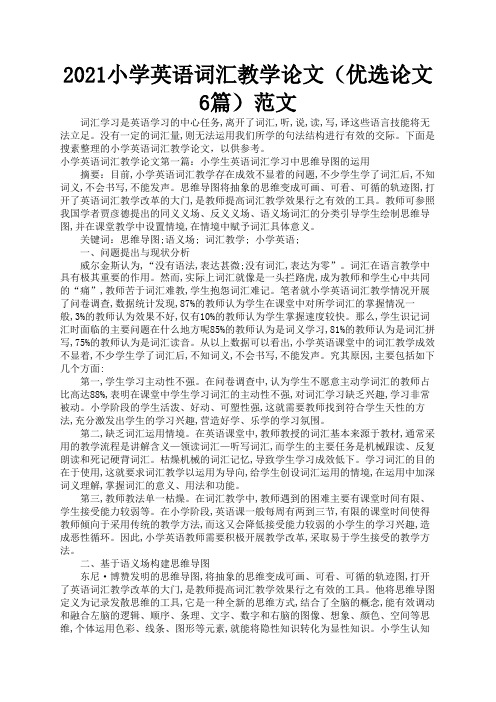
2021小学英语词汇教学论文(优选论文6篇)范文 词汇学习是英语学习的中心任务,离开了词汇,听,说,读,写,译这些语言技能将无法立足。
没有一定的词汇量,则无法运用我们所学的句法结构进行有效的交际。
下面是搜素整理的小学英语词汇教学论文,以供参考。
小学英语词汇教学论文第一篇:小学生英语词汇学习中思维导图的运用 摘要:目前,小学英语词汇教学存在成效不显着的问题,不少学生学了词汇后,不知词义,不会书写,不能发声。
思维导图将抽象的思维变成可画、可看、可循的轨迹图,打开了英语词汇教学改革的大门,是教师提高词汇教学效果行之有效的工具。
教师可参照我国学者贾彦德提出的同义义场、反义义场、语义场词汇的分类引导学生绘制思维导图,并在课堂教学中设置情境,在情境中赋予词汇具体意义。
关键词:思维导图;语义场; 词汇教学; 小学英语; 一、问题提出与现状分析 威尔金斯认为,“没有语法,表达甚微;没有词汇,表达为零”。
词汇在语言教学中具有极其重要的作用。
然而,实际上词汇就像是一头拦路虎,成为教师和学生心中共同的“痛”,教师苦于词汇难教,学生抱怨词汇难记。
笔者就小学英语词汇教学情况开展了问卷调查,数据统计发现,87%的教师认为学生在课堂中对所学词汇的掌握情况一般,3%的教师认为效果不好,仅有10%的教师认为学生掌握速度较快。
那么,学生识记词汇时面临的主要问题在什么地方呢85%的教师认为是词义学习,81%的教师认为是词汇拼写,75%的教师认为是词汇读音。
从以上数据可以看出,小学英语课堂中的词汇教学成效不显着,不少学生学了词汇后,不知词义,不会书写,不能发声。
究其原因,主要包括如下几个方面: 第一,学生学习主动性不强。
在问卷调查中,认为学生不愿意主动学词汇的教师占比高达88%,表明在课堂中学生学习词汇的主动性不强,对词汇学习缺乏兴趣,学习非常被动。
小学阶段的学生活泼、好动、可塑性强,这就需要教师找到符合学生天性的方法,充分激发出学生的学习兴趣,营造好学、乐学的学习氛围。
小学英语词汇教学论文六篇

小学英语词汇教学论文六篇学校英语词汇教学论文范文11.1图片演示图片演示是最普遍的一种方法。
目前,《PEP学校英语》教材最大的特点就是在出示新单词时都配有图片,这样图文并茂,同学心眼合一,认知更加简洁,更加难忘。
而且这些图片基本上是卡通的,符合学校生的认知心理。
例如学习panda,cat,kangaroo,goat等这类单词时出示相应图片,鲜亮的颜色,可爱的卡通图画一下子就吸引了同学的留意力,充分调动了同学的学习乐观性,激发了学习爱好。
简笔画、挂图、插图,幻灯片等呈现课文情境,实际上就是把课文内容形象化,给同学留下深刻的印象,关心同学直接理解并运用所学的内容。
1.2实物演示英语课和其它课相比最大的特点就是能把实物带进课堂,把生活中的诸多真实生活实例经过细心预备搬进课堂,使同学觉得这不是正襟危坐的课堂,为营造轻松开心的课堂氛围埋下了伏笔。
单词教学可由实物来呈现其意思,例如教学食物、衣物、书刊、小玩具、文具等单词时可用实物来结合教学。
比如学习《PEP英语》6B中seed,soil,sprout,plant时,笔者事先将种子、土、幼苗和植物带进了教室,在教授新词时,先通过实物演示教会同学单词,再通过亲自种植等一系列活动向同学演示植物的种植过程,这样教学不但避开了单调枯燥的单词教学,还教会了同学植物的种植方法,真正做到寓教于乐。
2归类记忆法归类记忆法是将分散、零星的一些单词按不同类别划为一组进行系统记忆的方法,特别适合六班级同学在总复习阶段学习单词时运用。
例如:表示水果的单词apple,banana,pear,pineapple,lemon,strawberry,peach,mango等;表示食物类的单词:dumpling,sandwich,hamburger,bread,rice,milk等;表示交通工具的单词:car,bus,plane,sled,ship,subway,bike等。
这种方法使用很普遍,学校阶段大部分所学单词都可以像这样按类别进行归纳,如:方向,文具,生活用品,家庭成员,天气,颜色,时间,运动,人体各部位等。
词汇学论文

英语的发展这学期我们学习了词汇学这门课程,从这门课程的学习中我了解了英语发展的历史。
从这门课的学习中,我知道了英语语言的历史发展可以分为三个阶段,分别是:古英语(Old English),中世纪英语(Middle English)和现代英语(Modern English)。
(一) 古英语时期 (Old English Period, 450-1150)。
有记载的英语语言起始于449年,当时包括央格鲁-撒克逊人(Angles-Saxons)在内的德国部落入侵大不列颠。
他们把原来的居民凯尔特人(the Celts)赶到不列颠的北部和西部角落。
凯尔特人的领袖King Arthur带领部队勇敢作战,英勇抗击德国入侵者。
这之后在不列颠岛上央格鲁人、撒克逊人和一些德国部落都说着各自的英语。
尽管85%的古英语词汇现在已经不再使用,但一些常用词汇如:child, foot, house, man, sun等等还是保留下来。
和现代英语相比,古英语中的外来词很少,但派生词缀较多。
古英语中还有较多描述性的复合词。
如“音乐”是earsport;“世界”是age of man。
在著名的英雄史诗《贝奥武甫》(Beowulf)中对此有详尽描述。
这是最早居住在不列颠(Britain) 的民族塞尔特人所说的塞尔特语(Celtic),他们虽然最早到英国,但留下来的事迹不多,现在威尔斯、苏格兰高地仍有人说塞尔特语。
公元前43年凯撒大帝征服不列颠,罗马人统治不列颠人,同时也将当时罗马人使用的拉丁语传入,但并未被一般老百姓采用。
公元410年罗马帝国自英国撤离,这时,来自英国北方的皮刺人 (Picts) 和苏格兰人分别从南部和西北侵扰,不列颠无力抵抗,只好求救于往昔经常困扰罗马军队的日耳曼人。
根据大英民族编年史的记载,日耳曼民族于公元449年在英格兰登陆,将日耳曼语带到英国,而发展成现在的英语,因此,英语是属于印欧语系Indo-European 日耳曼语族的语言。
英语词汇学的论文怎么写[共5篇]
![英语词汇学的论文怎么写[共5篇]](https://img.taocdn.com/s3/m/6ecb7b3191c69ec3d5bbfd0a79563c1ec5dad7fa.png)
英语词汇学的论文怎么写[共5篇]第一篇:英语词汇学的论文怎么写英语词汇学的论文怎么写?英语词汇学习在英语词汇学习过程中,学习者要遵循第二语言习得的规律,掌握并灵活运用多种词汇学习策略。
可分为词汇表策略、语境策略、精加工策略、语义场策略。
一.词汇表策略(Word list strategy)词汇表策略一般为:一列是按字母顺序排列的英语单词,另一列是这些单词的汉语意思(等值词、同义词或近义词)。
有些学者认为,通过词汇表策略能够迅速且有效地学会大量的词汇。
然而,Gaims 和Redman 却指出,通过词汇表记忆词汇会阻碍对所记词汇进行充分地处理和系统地组织,因此就失去了有效的长时记忆的基础。
语言大师桂诗春教授也认为,词汇表策略既费时又费力,徒劳无功,因为这种做法不仅把外语的词语和母语的词语等同起来,而且把它从语言和语境中孤立出来。
二.语境策略(Context strategy)语境策略就是学习者通过上下文语言环境所提供的信息对出现在语境中的生词进行猜测,从而习得这个单词。
语境策略是目前比较流行的词汇学习策略之一,它不仅仅可以扩大词汇量,而且可以让学生了解有关目的语的文化知识。
但是,Channell(Carter &McCarthy ,1988:89)认为,音节认知和重音认知对学习者理解词汇起着非常重要的作用。
为了更好地理解词汇,学习新单词的方法应使学习者准确地内化和吸收新单词:即学会单个音标的发音、了解音节数、掌握重音位置。
从这一方面来看,运用语境策略学习词汇不能算是一个很好的方法。
三.精加工策略(Elaborative strategy)精加工策略是指通过对学习材料进行深入细致的分析、加工,理解其内在的深层意义并促进记忆的一种策略。
皮连生(1998)在《学与教的心理学》一书中也曾提到:“精细加工策略”(同“精加工策略”)指对学习材料作精细的加工活动,即通过在要记忆的材料上增加相关的信息来达到对新的材料记忆的学习方法。
词汇学论文

Know More about X-rayAfter a semester's study of Lexics, I had learned a lot about words and vocabulary. Here I am going to introduce the word "X-ray". I will mainly cover four parts: What X-ray is; when, where, how and by whom it had been discovered; the uses of X-ray; and the harmful effects it has.First, what is X-ray?X-ray, can also be called Radiography, is a form of electromagnetic radiation, just like visible light. X-rays are electromagnetic waves like radio and light waves. These all travel at the speed of light, which is 300 000km per second.As the wavelengths of light decrease, they increase in energy. The wavelength of an X-ray however is one hundredth that of the light rays that you can see, at around 10¯¹ºm. This means that X-rays have higher energy than ultraviolet waves. We usually talk about X-rays in terms of their energy rather than wavelength. This is partially because X-rays have very small wavelengths. It is also because X-ray light tends to act more like a particle than a wave.X-ray detectors collect actual photons of X-ray light which is very different from the radio telescopes that have large dishes designed to focus radio waves. In fact, X-ray fluorescence is the emission of X-rays from excited atoms produced by the impact of high-energy electrons, other particles or a primary beam of other X-rays. Atoms of all the elements emit a characteristic X-ray spectrum when they are bombarded with electrons. The X-ray photons are emitted when the incident electrons knock an inner orbital electron out of an atom. When this happens, an outer energy electron falls into the inner shell to replace it, losing potential energy in doing so.Second, when, where, how and by whom had the X-ray been discovered?X-rays were first observed and documented in 1895 by Wilhelm Conrad Roentgen, a German scientist who found them quite by accident when doing some experiments in which he passed an electric current through Crookes tubes (special tubes containing a cathode and electrode from which the air has been removed),Roentgen noticed that photographic plates nearby began to grow fogged. To discover why this occurred he placed black paper on the tube and then switched on the current. Nearby a screen coated with barium began to glow. This caused Roentgen to believe that unknown rays produced inside the tube were passing through the paper to make this fluorescent substance give out light.A week later, he took an X-ray photograph of his wife's hand which clearly revealed her wedding ring and her bones. The photograph electrified the general public and aroused great scientific interest in the new form of radiation. Roentgen called it "X" to indicate it was an unknown type of radiation. The name stuck, although (over Roentgen's objections), many of his colleagues suggested calling them Roentgen rays. They are still occasionally referred to as Roentgen rays in German-speaking countries.The occurrence of X-rays is not just on the Earth. Many things in deep space give off X-rays. Many stars are in binary star systems which mean that two stars orbit each other. When one of these stars is a black hole or a neutron star, material is pulled off the normal star. This materials spirals into the black hole or neutron star and heats up to very high temperatures. When something is heated to over a million degrees, it will give off X-rays. Recently, we learned that even comets emit X-rays. The Sun also emits X-rays. But, the Earth's atmosphere is thick enough that virtually no X-rays are able to penetrate from outer space all the way to the Earth's surface. This is good for us but also bad for astronomy - we have to put X-ray telescopes and detectors on satellites! We cannot do X-ray astronomy from the ground.The Earth glows in many kinds of light, including the energetic X-ray band. Actually, the Earth itself does not glow; only aurora produced high in the Earth's atmosphere. These auroras are caused by charged particles from the Sun. The energetic charged particles from the Sun that cause aurora also energize electrons in the Earth's magnetosphere. These electrons move along the Earth's magnetic field and eventually strike the Earth's ionosphere, causing the X-ray emission. These X-rays are not dangerous because they are absorbed by lower parts of the Earth's atmosphere.Third, what are the uses of X-ray?It has been found that X-rays reach the Earth from outer space. Mysterious objects called quasars give out huge amounts of X-ray energy. X-rays can pass through many forms of matter and therefore have many uses. X-rays are produced for these purposes by an X-ray tube.The first medical use of X-rays came in 1896. It was American physiologist Walter Bradford Cannon who used a fluorescent screen to follow the path of barium sulfate through an animal's digestive system. This was possible only after Thomas Alva Edison invented the X-ray fluoroscope that same year. Soon after, physicians worldwide began using X-rays on humans, usually to examine bone fractures or to search for foreign objects such as bullets.The main use of X-rays is in medicine. A common application is in the form of X-ray machines, which take photos of a patient’s body. If an arm or leg were broken for example, then this limb would be put in front of the X-ray with a piece of photographic film behind. The X –ray is turned on briefly and goes through to the film. The rays go through the skin and flesh easily, showing up as dark areas on the film, but with more difficulty through bone. They are slowed down and so these areas are much lighter. X-rays can also be used to kill cancer cells, but also kill healthy cells, so must be used with much care.Apart from its useful medical implementation, X-ray has a wide range of industrial and other scientific uses as well. X-ray is often used to detect the integral condition and strength of a structure and thus both aircraft and car manufacturers use it as an important tool to make and maintain their manufactures.Although X-rays have been so widely used, they are not advised by doctors nowadays, unless necessary and that too with sufficient gaps in between them. The simple reason behind this precaution is that over-exposure to X-rays damage living tissues and cells and may cause them to develop cancer. What's more, X-rays can harm the tissue in the bones which is called bone marrow. X-ray can cause baldness that is the loss of hair on the head. X-rays also cause cancer development, thyroid cancer and invisible spectrum. X-rays have biological radiation effects, which are observed when ionizing radiation strikes living tissue and destroys the molecules ofcellular matter. Birth defects are also known as congenital disorders are abnormalities of structure or function that exists at birth. Pregnancy and childbirth imply the gestation period of the human reproductive cycle. Bone marrow is a soft and pulpy tissue that fills the bone cavities, which occur in two forms i.e. red and yellow. Hair loss is a baldness or alopecia that is partial or complete loss of hair affecting the scalp. Thyroid cancer also known as endocrine gland occurs in all vertebrate animals.Although exposure to X-ray radiation can lead to such problems as discussed in the above paragraphs, it is an essential part of medical diagnosis and is unavoidable in certain cases. Practicing caution and avoiding over-exposure are the keys to avoid such effects on your body.Ironically, the harmful side effects of X-ray scanning have suggested yet another use for the procedure called radiotherapy. In this therapy, very high frequency X-rays are used to destroy cancer cells. Radiotherapy is most often used in conjunction with chemotherapy (cancer medicine that is taken by mouth).If you want to some more detailed information, you can resort to the Internet.。
初中英语词汇教学论文(汇总8篇)

初中英语词汇教学论文(汇总8篇)篇1:初中英语词汇教学论文曾经在学生中做过这样的调查:“学英语,你最怕的是什么?”各种各样的答案都有,有的说害怕语法,有的说害怕作文,有的说害怕听力,但答得最多的却是害怕背单词,尤其是新教材,原来的《英语教学大纲》中规定初中毕业的学生掌握800个左右的单词即可,现如今的《英语课程标准》则要求在1500个左右,在各个科目纷纷“减负”的同时,唯独英语学科在默默承受着“增压”的痛苦,于是就出现了“单词是基础,词汇是拦路虎,背单词真痛苦”的现象。
教学的过程是师生互动的过程,词汇教学也是如此,800个得教,1500个也得教,只是苦了学生,累了教师罢了。
要想让学生掌握好词汇,关键是让学生对英语产生兴趣,把背单词当作一种苦中作乐的事,而要做到这样,又是相当的不容易,除了学生自觉外,教师采用不同的教学方法来帮助调动学生的积极性,也是很重要的。
(一)针对词汇量多的问题,初步统计一下,每个话题的单词少则二三十个,多则五六十个,以前教的时候多是要求学生全部要掌握,胡子眉毛一把抓。
结果是有的学生接受得来,而有的学生一看那么多单词,实在是件痛苦的事,干脆就不背了,反正是死猪不怕开水烫,任你老师罚呗,他自有办法应付,这终究不是好办法。
现如今则稍作改变,要求四会的黑体单词,中下水平的学生要求掌握,至于学有余力的学生,就要求掌握黑体和三会的白体单词,打三角形的只需要了解就可以。
相信大多数老师和我的感受相差不多,对于800个变成1500个毫无心理准备。
以前词汇少时,一星期教一次单词和听写一次就行,如今每个话题单词少的也要分两次教,多的则要分为三次教才行,当然听写也随之水涨船高,次数增多了,不这样做学生根本接受不了。
(二)所谓的“教无定法,教有良法”说明白些,其实就是依据学生具体情况而选择适当的教学方法。
以下是我课堂教学中较为常用的方法。
1音标教学法:七年级英语刚入门时,教师在字母教学法中应该融入音标教学,可以要求学生学会制作音标卡,并要求他们背诵48个国际音素。
英语词汇学论文-构词法
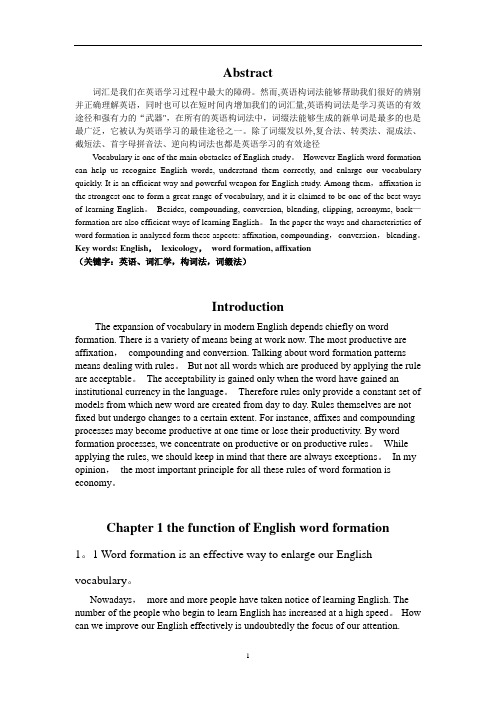
Abstract词汇是我们在英语学习过程中最大的障碍。
然而,英语构词法能够帮助我们很好的辨别并正确理解英语,同时也可以在短时间内增加我们的词汇量,英语构词法是学习英语的有效途径和强有力的“武器",在所有的英语构词法中,词缀法能够生成的新单词是最多的也是最广泛,它被认为英语学习的最佳途径之一。
除了词缀发以外,复合法、转类法、混成法、截短法、首字母拼音法、逆向构词法也都是英语学习的有效途径Vocabulary is one of the main obstacles of English study。
However English word formation can help us recognize English words, understand them correctly, and enlarge our vocabulary quickly. It is an efficient way and powerful weapon for English study. Among them,affixation is the strongest one to form a great range of vocabulary, and it is claimed to be one of the best ways of learning English。
Besides, compounding, conversion, blending, clipping, acronyms, back—formation are also efficient ways of learning English。
In the paper the ways and characteristics of word formation is analyzed form these aspects: affixation, compounding,conversion,blending。
词汇学论文
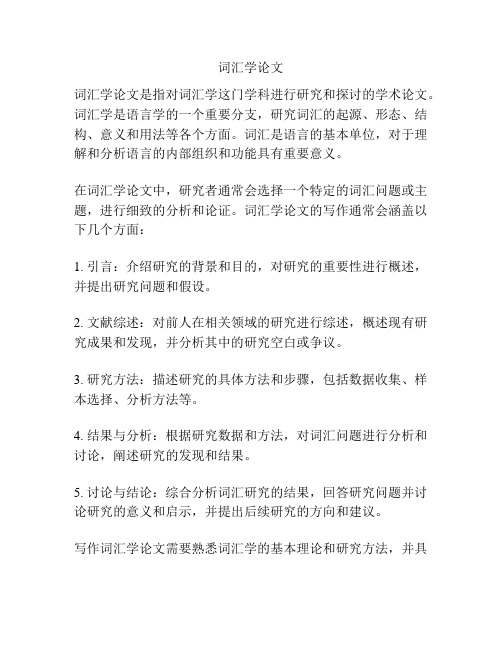
词汇学论文
词汇学论文是指对词汇学这门学科进行研究和探讨的学术论文。
词汇学是语言学的一个重要分支,研究词汇的起源、形态、结构、意义和用法等各个方面。
词汇是语言的基本单位,对于理解和分析语言的内部组织和功能具有重要意义。
在词汇学论文中,研究者通常会选择一个特定的词汇问题或主题,进行细致的分析和论证。
词汇学论文的写作通常会涵盖以下几个方面:
1. 引言:介绍研究的背景和目的,对研究的重要性进行概述,并提出研究问题和假设。
2. 文献综述:对前人在相关领域的研究进行综述,概述现有研究成果和发现,并分析其中的研究空白或争议。
3. 研究方法:描述研究的具体方法和步骤,包括数据收集、样本选择、分析方法等。
4. 结果与分析:根据研究数据和方法,对词汇问题进行分析和讨论,阐述研究的发现和结果。
5. 讨论与结论:综合分析词汇研究的结果,回答研究问题并讨论研究的意义和启示,并提出后续研究的方向和建议。
写作词汇学论文需要熟悉词汇学的基本理论和研究方法,并具
备相关的研究技巧和分析能力。
同时,严谨的逻辑思维和清晰的表达能力也是写好词汇学论文的关键。
词汇学论文2篇
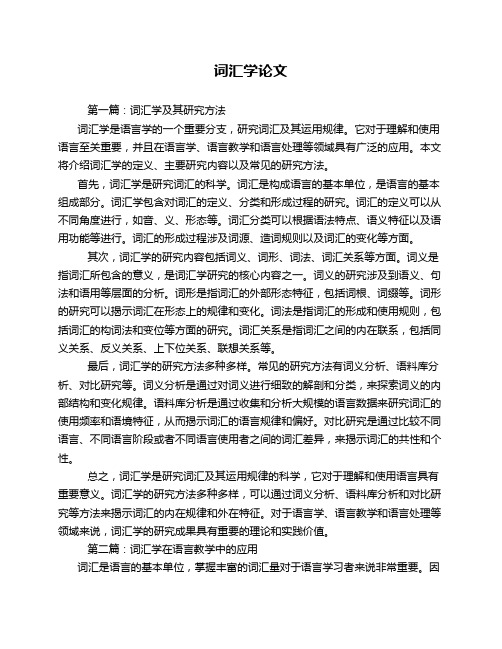
词汇学论文第一篇:词汇学及其研究方法词汇学是语言学的一个重要分支,研究词汇及其运用规律。
它对于理解和使用语言至关重要,并且在语言学、语言教学和语言处理等领域具有广泛的应用。
本文将介绍词汇学的定义、主要研究内容以及常见的研究方法。
首先,词汇学是研究词汇的科学。
词汇是构成语言的基本单位,是语言的基本组成部分。
词汇学包含对词汇的定义、分类和形成过程的研究。
词汇的定义可以从不同角度进行,如音、义、形态等。
词汇分类可以根据语法特点、语义特征以及语用功能等进行。
词汇的形成过程涉及词源、造词规则以及词汇的变化等方面。
其次,词汇学的研究内容包括词义、词形、词法、词汇关系等方面。
词义是指词汇所包含的意义,是词汇学研究的核心内容之一。
词义的研究涉及到语义、句法和语用等层面的分析。
词形是指词汇的外部形态特征,包括词根、词缀等。
词形的研究可以揭示词汇在形态上的规律和变化。
词法是指词汇的形成和使用规则,包括词汇的构词法和变位等方面的研究。
词汇关系是指词汇之间的内在联系,包括同义关系、反义关系、上下位关系、联想关系等。
最后,词汇学的研究方法多种多样。
常见的研究方法有词义分析、语料库分析、对比研究等。
词义分析是通过对词义进行细致的解剖和分类,来探索词义的内部结构和变化规律。
语料库分析是通过收集和分析大规模的语言数据来研究词汇的使用频率和语境特征,从而揭示词汇的语言规律和偏好。
对比研究是通过比较不同语言、不同语言阶段或者不同语言使用者之间的词汇差异,来揭示词汇的共性和个性。
总之,词汇学是研究词汇及其运用规律的科学,它对于理解和使用语言具有重要意义。
词汇学的研究方法多种多样,可以通过词义分析、语料库分析和对比研究等方法来揭示词汇的内在规律和外在特征。
对于语言学、语言教学和语言处理等领域来说,词汇学的研究成果具有重要的理论和实践价值。
第二篇:词汇学在语言教学中的应用词汇是语言的基本单位,掌握丰富的词汇量对于语言学习者来说非常重要。
词汇学论文

March摘要:‘march’一词有动词,名词两种词性,不同的词性中又有不同的含义,进而产生出多种搭配。
一个词从古到今,它的意义会根据时代不同而有变化,有所增减。
再加上在不同的文化当中也会有不同的使用。
我主要从‘march’这个词的词源,词义,词的派生,词的文化意义以及它在实际当中的运用等方面多方位研究。
关键字:march 多方位研究1.词义:‘march’有动词和名词两种词性。
作动词时:齐步前进,行军,进展,游行示威,排成整齐的行列,使(部队等)前进,使行军,使行进以及一种罕用语‘交界’。
作名词时:行军,进行,步伐,进行曲,行程,长途跋涉,游行示威,[美国俚语](马戏团)吹打过市,边界,(两国间有争议的)边界区,[常作the Marches]英格兰与苏格兰(或威尔士)的接界地区,3月,Morava (捷克)的德语名称。
2.词源:作为本意之一‘行军’:军队徒步或乘车沿指定路线进行的有组织的移动。
古代泛指用兵,扩充军备,行营;作为名词之一‘March’——三月:March原来是一年中最早的一个月,以罗马神话中的战神Mars 命名。
在早期罗马的历史中,马尔斯是春之神,象徵了自然界的生长和繁殖,他还是牛羊的保护神和大地之神。
后来他把农神的职责交给了克瑞斯(对应希腊神话里的德墨忒尔),成为单纯的罗马时期的城池保护神。
马尔斯的职责象徵了罗马人同时作为农民和战士的双重身份。
在大多数传说中,他是Jupiter和Juno 的儿子(即宙斯与赫拉)在奥维德的叙述中,他是因花神给予赫拉的一枝花受孕而生。
马尔斯常穿一身鲜亮的铠甲,一手拿长矛,一手拿盾牌,是位长相英俊的青年的形象。
陪伴他的是司战女神贝娄娜。
马尔斯和他的父亲朱庇特共享神庙,罗马的军队就从那里出发的。
而他自己的领地也在城墙外,那是训练士兵和运动员的地方。
当士兵们启程时,领头的将军要大喊:醒来吧,战神!因为战事往往在一年的3月重开,所以三月以战神的名字命名。
3.词的派生:March的派生词,不多下面我例举几个:marcher (争取自由的示威者);marches(历史上遗威尔士留下来的边界,尤指英格兰与苏格兰或英格兰与威尔士的结界地区);marchioness(侯爵夫人,侯爵遗孀)。
英语词汇学论文

PINGDINGSHAN UNIVERSITY《英语词汇学》课程论文论文题目词汇学的重点内容及其在外语学习中的辅助作用院系: 外国语学院专业年级: 2012级英语师范专业*名:**学号: *********指导教师:韩福领副教授2015年6月25日词汇学的重点内容及其在外语学习中的辅助作用摘要英语词汇普遍存在于各种语体中而且对各种语体的言语交际至关重要,因此引起许多语言学家的关注,他们从不同的角度对其进行研究。
本文在对这些研究进行回顾和总结的基础上,尝试分析英语词汇学与二外学习的关系、主要内容及其现实意义.关键词:英语词汇学;内容;作用.目录摘要-—-——-————-————------——--—-—-——---—-—-———--—-———-—-—-———--——---————---—-——---—-—---——---—-—2目录—--————---—--—----———-———-—----—-———--—---——-———--—--———————-—----——-——-—---——--—-——----—————3内容 1英语词汇学的内容简介——-——-————-----—-——-————-—————---—-——-—-————-—-——---—--—41。
1词的概述-————-—--—-—---———-————-——-——————--—-—--———---—-———--———-———-—————-—--——---—错误!未定义书签。
1。
2 英语词汇学的主要内容--——-——-—-—-—--———-—————-—---—-——-—---——-—------—-—-—--——-—错误!未定义书签。
1.3英语词汇学中的重点—-———--——-—---—-—-—-—-———-——-—-—-————-———-——-—---—-----————-42词汇学在第二语言学习中的作用-—-————-—--—————--——-—--—-——-——-————-—-—---—-———---—52.1构词法在第二语言学习中的作用-—-—-----—-——-———-——---——-—-——---—-——--——-—-—-——-—52.2词义变化在第二语言教学中的作用-———-—-——-—-—-———-—-—————-——-——--——--—--—--—-———----——52。
词汇学论文

词汇学论文对英语构词法的一点认识英语116班说实话,整本英语词汇学教程学下来,留在我脑子中的东西并不多,但惟独对第四章构词法(word formation)印象很深。
这一章一共介绍了9种构词法,分别是:词缀法(affixation)、组合法(compounding)、转换法(conversion)、混合法(blending)、缩略词法(clipping)、首字母缩写法(acronymy)、逆构法(back-formation)、声音重复法(sound reduplication)以及专有名词的泛化(commonization of proper names)。
今天我在这里想谈谈主要的4种构词法:词缀法(affixation)、合成法(compounding)、转换法(conversion)、混合法(blending)以及对它们的一些认识。
(一)词缀法(affixation)在所有的英语构词法中,词缀法能够生成的新单词是最多的也是最广泛,它被认为英语学习的最佳途径之一。
1.前缀法(prefixation):在词根前加前缀,多数情况下词类不变。
主要有一下几种情况:表否定意思的前缀、表示相反的或者剥夺性质的前缀、表示变坏的前缀、表示范围和程度的前缀、表示方向和态度的前缀、表示方位的前缀、表示时间和顺序的前缀、表示数字的前缀、转化前缀以及其他类型的前缀。
2.后缀法(suffixation):在词根后面加后缀,多数情况下词类改变。
后缀主要有名词后缀、形容词后缀、副词后缀和动词后缀。
3.中缀法(infixation):很少见,加中缀通常表明演讲者的态度,并且不会改变单词的词性和意思。
事实上,在词汇学的书里也没有提到中缀,我也只是在语言学的课上知道还有中缀这么一种词缀。
(二)合成法(compounding)合成也许是最常见的扩大英语词汇量的方式,它允许使用者将两个或两个以上熟悉的词组合在一起形成一个新的词,产生新的语义。
《英语词汇学教程》论文(中文版)免费范文
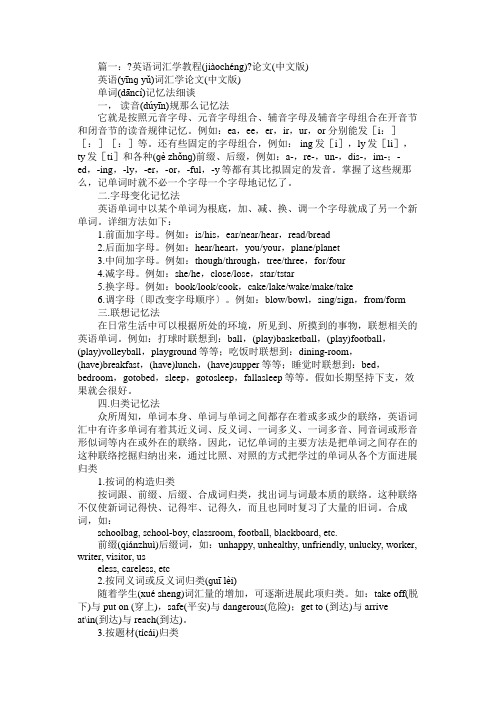
篇一:?英语词汇学教程(jiàochéng)?论文(中文版)英语(yīnɡ yǔ)词汇学论文(中文版)单词(dāncí)记忆法细谈一,读音(dúyīn)规那么记忆法它就是按照元音字母、元音字母组合、辅音字母及辅音字母组合在开音节和闭音节的读音规律记忆。
例如:ea,ee,er,ir,ur,or分别能发[i:][:][:]等。
还有些固定的字母组合,例如: ing发[i],ly发[li],ty发[ti]和各种(ɡè zhǒnɡ)前缀、后缀,例如:a-,re-,un-,dis-,im-;-ed,-ing,-ly,-er,-or,-ful,-y等都有其比拟固定的发音。
掌握了这些规那么,记单词时就不必一个字母一个字母地记忆了。
二.字母变化记忆法英语单词中以某个单词为根底,加、减、换、调一个字母就成了另一个新单词。
详细方法如下:1.前面加字母。
例如:is/his,ear/near/hear,read/bread2.后面加字母。
例如:hear/heart,you/your,plane/planet3.中间加字母。
例如:though/through,tree/three,for/four4.减字母。
例如:she/he,close/lose,star/tstar5.换字母。
例如:book/look/cook,cake/lake/wake/make/take6.调字母〔即改变字母顺序〕。
例如:blow/bowl,sing/sign,from/form三.联想记忆法在日常生活中可以根据所处的环境,所见到、所摸到的事物,联想相关的英语单词。
例如:打球时联想到:ball,(play)basketball,(play)football,(play)volleyball,playground等等;吃饭时联想到:dining-room,(have)breakfast,(have)lunch,(have)supper等等;睡觉时联想到:bed,bedroom,gotobed,sleep,gotosleep,fallasleep等等。
词汇学论文(英文的)
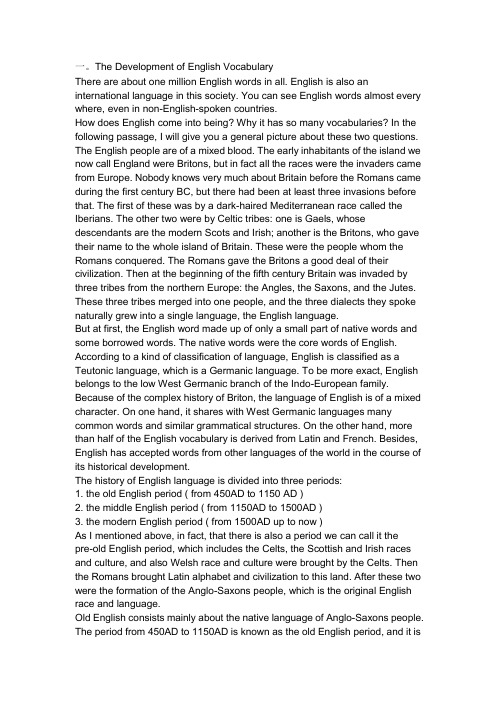
一。
The Development of English VocabularyThere are about one million English words in all. English is also an international language in this society. You can see English words almost every where, even in non-English-spoken countries.How does English come into being? Why it has so many vocabularies? In the following passage, I will give you a general picture about these two questions. The English people are of a mixed blood. The early inhabitants of the island we now call England were Britons, but in fact all the races were the invaders came from Europe. Nobody knows very much about Britain before the Romans came during the first century BC, but there had been at least three invasions before that. The first of these was by a dark-haired Mediterranean race called the Iberians. The other two were by Celtic tribes: one is Gaels, whose descendants are the modern Scots and Irish; another is the Britons, who gave their name to the whole island of Britain. These were the people whom the Romans conquered. The Romans gave the Britons a good deal of their civilization. Then at the beginning of the fifth century Britain was invaded by three tribes from the northern Europe: the Angles, the Saxons, and the Jutes. These three tribes merged into one people, and the three dialects they spoke naturally grew into a single language, the English language.But at first, the English word made up of only a small part of native words and some borrowed words. The native words were the core words of English. According to a kind of classification of language, English is classified as a Teutonic language, which is a Germanic language. To be more exact, English belongs to the low West Germanic branch of the Indo-European family. Because of the complex history of Briton, the language of English is of a mixed character. On one hand, it shares with West Germanic languages many common words and similar grammatical structures. On the other hand, more than half of the English vocabulary is derived from Latin and French. Besides, English has accepted words from other languages of the world in the course of its historical development.The history of English language is divided into three periods:1. the old English period ( from 450AD to 1150 AD )2. the middle English period ( from 1150AD to 1500AD )3. the modern English period ( from 1500AD up to now )As I mentioned above, in fact, that there is also a period we can call it thepre-old English period, which includes the Celts, the Scottish and Irish races and culture, and also Welsh race and culture were brought by the Celts. Then the Romans brought Latin alphabet and civilization to this land. After these two were the formation of the Anglo-Saxons people, which is the original English race and language.Old English consists mainly about the native language of Anglo-Saxons people. The period from 450AD to 1150AD is known as the old English period, and it isalso been called Anglo-Saxons period. It is described as the period of full inflections, since during most of this period the case endings of the noun, the adjective, and the conjugation of the verb were not weakened. Also during this period, when the Norman Conquest in 1066AD brought French to England, and much of the English vocabulary was replaced by words borrowed from French and Latin.Old English is a synthetic language. (There are two classes of languages in the world: synthetic and analytic. A synthetic language is one which shows the relation of words in a sentence largely by means of inflections. An analytic language is one which indicates the relation of words in a sentence by means of word order, prepositions or auxiliary verbs, rather than by inflections.) Old English nouns and adjectives have four cases: the nominative case, the genitive case, the dative case and the accusative case. Apart from these four cases, Latin nouns have the ablative and locative cases.Middle English period is from 1150AD to 1500AD. During this period the inflections which had begun to break down towards the end of the old English period, became greatly reduced, and it is known as the period of leveled inflections. The Norman Conquer was the cause of this change. The change of this period had a great effect on both grammar and vocabulary. In grammar English has changed from a highly inflected language to an analytic language. In this period many old English words were lost, but thousands of words borrowed from French and Latin appeared in the English vocabulary. French influence on the English vocabulary is much more direct and observable. The number of French words that came into English was very numerous. More than half of the English vocabulary is derived from Latin.Modern English period is from 1500 to the present. A large part of the original inflectional system has disappeared, and it is known as the period of lost inflections. We may divide this period into two parts: the early Modern English period and the Late Modern English period.The early modern English period extends from 1500AD to 1700AD. The chief influence of this time was the great humanistic movement of the Renaissance. In this period the study of the Latin and Greek classics was stressed, so the influence of Latin and Greek on English was great.The late modern English period started after 1700AD. The eighteenth century in England was a time of stabilizing and purifying the English language. The publication in 1755AD of A Dictionary of the English Language edited by Samuel Johnson was a typical example of consolidating and purifying the English language in this period. He set a standard for using English words in spelling, meaning and usage. In the eighteenth century French greatly influenced English. The number of French words in the period from 1650AD to 1800AD increased rapidly. Such as: ballet, cartoon, champagne, cohesion, dentist, patrol, publicity, routing, etc.Meanwhile the territorial expansion of the English empire in this period resulted in the expansion of the English vocabulary. Thus, there are many words flow into English vocabulary, which includes American Indian words, Mexican words, Peru words, Brazil words, India and African words.The nineteenth and twentieth centuries are a period of rapid expansion for the English vocabulary in the history of the English language. In this period many changes have taken place. Especially the great development of science and technology is reflected in the English vocabulary.Besides, the great changes in industry, in political and social lives, in sports and amusements all have contributed a great deal to the English vocabulary. Since the Second World War the English vocabulary has been affected powerfully by social, political, economic, especially scientific and technical changes. The English vocabulary not only changes, but also changes quickly in this period. Thousands of new words are added, existing words acquire new meaning and old words die out.Till now, the English vocabulary is still changing, some words come out and some die out. In a word, as society is constantly in a state of development, so is language. Society depends on language for its existence. As society develops new objects are created that require the invention of new words and expressions. Therefore, the changing of English vocabulary is an endless changing process.Bibliography:陆国强,published in 1999,Modern English Lexicology (new edition)Adams, Valerie, published in1982,An Introduction to Modern English Word-formation戴炜栋,published in 2002,A New Concise Course on Linguistics for Students of English朱永涛,published in 1997,The Society and Culture of Major English-speaking Countries林承璋,published in 1987,An Introduction to English Lexicology也可以写广告中的词汇特点:The Lexical Features of Advertisement on NewspaperNewspapers are generally the cheapest way to reach a mess audiences,and the timing is fast.Adverments make an important part on English Newspaper.We live in a world of advertising.Advertising provides a valuable service to society and its members,because it defines for consumers the meaning and the role of products,services and institutions.Newspaper advertisements’ main text use words for the spread of vector,and must must be simple eye-catching,because of the layout of resources.To some extent,thenewspaper advertisements content mainly rely on language toexpress.Advertising language ,playing a role of communication and persuasion,has developed its own features.Naturally,advertisements in English have become an important means of communicatingideas,demoinstrating a variety of linguistic features of its own.The present study discusses some lexical features of English advertisement texts.ⅠChoose the simple wordsAdvertiment language must be easily understood terms so that readers can get information as soon as possible.In advertising,simple words can win the consumers by their exact,effective expression an d a kind of closeness.E.g.①Take time.Any time.Continuous using two “time” can make the language simple and clear.②Once tasted,always loved.The article should be clearly and concisly understood in order to arouse the interest of customers on food which make them mouth-watering.③My goodness!My Guinness!Common language facilitate people to memory and speak,this reproduce the scene of people driking the Guinness beer which is full of praise.ⅡFrequent Employment of Simple VerbsSimple verbs are frequently employed in English advertisements, which is an obvious wording characteristics of English advertising texts.Verbs are the most important part of language.It is a prominent feature in adervertising english that verbs are regularly used for the ultimate goal of advertising ,which is to enable consumers to buy their goods.So in terms of the using of words,dynamic and strong word will produce a better feeling effects.Verbs can be used to “touch”the consumer's heart.In this way,they will have impules to buy the goods.E.g.①Drink Coca-Cola.②I want you to sponsor a Rice Paddy Baby.③For incredible speed and accuracy, try the Minolta 7000, the world’s first body-integral auto-focus SLR.In the above examples, “try”,”sponsor” and “drink”are to fulfill the “get action” requirement seem more euphemistic and even more attractive.④Get noticed. Get results.⑤Feel the Hyatt Touch.⑥Send today for your free sample, and try the new flavor.After reading the above ads, we feel encouraged to take buying action or make repeated purchases. The active voice doesn’t force people to take the passive action while it makes people feel that they do something of their own accord. Ⅲ. Adjectives⑴It is hard for us to think of any really persuasive message without the use of descriptive and vivid adjectives. Copywriters like to use a large number of adjectives not only to describe the quality and features of the products or services, but to a great extent to praise and beautify them.E.g.For people who care about their bodies, Dairy Farm brings fresh skimmed milk. With almost no fat, it keeps your body fit inside and outside, fresh skimmed milk. Fresh Dairy Farm.The adjective “fresh” in Example appears three times to emphasize how fresh the product is, making its quality particularly attra ctive. And the adjective “fit” points out the remarkable function of the product.⑵The copywriter tends to select the superlative or comparative forms of adjectives that carry positive meanings so as to make a comparison and stress the wonderful qualities of the advertised product. E.g.①Using Dove, I do feel 20 years younger.“Younger” just emphasizes the magic power of the product.②Discover the season’s newest splendor.The word “newest” , which is an advertisement of a kind of perfume, means “fashionable to the highest degree”.Of course, the advertisers must make sure that the advertised goods or services are actually the best in the same category.Sometimes people do not know how superb the goods or the services are in quality. Anyhow, people tend to believe what is said in advertisements.Ⅳ.New Words Constantly AppearIn order to attract people’s attention, copywriters like to create some new words which are more active. The new words are mainly used for truthfulness, humor or emphasis in English advertising texts. E.g.①Surefit Shoe Ltd.“Surefit” is a new word which makes consurms thing of a sentence”Surely to fit your feet”.That means the shoes are fot for your feet.②Give a Timex to all, and to all a good time.The well-known watch brand “Timex” is a variation of “Time + Excellent”, wh ich persuasively shows the merit of the watch brand. Thus, brand names get and retain a unique image.Ⅴ.PronousPronouns of the first and second person: we, I and you outnumber the other pronouns in advertisements. It is because that you, we and I help create a friend-like intimate atmosphere to move and persuade the audience. The audience will easily accept a product, a service or an idea as if a good friend recommended them.Sometimes,we use infinitive pronouns,such asall,everyone,none,nothing and so on in order to feflect the extraordinarycharacteristics of a particular commodity or it has been spending and receiving most of people.E.g.Our finest time.It is about a well-known red wine.A pair of lover drink together at romantic atmosphere.Ⅵ.Compound wordsA compound word is often a noun or an adjective made up of two or more words which are frequently used to express more information in limited space. Especially,compound adjectives are often seen in advertisements.E.g.Kodak Single-use-came ras take pictures where you wouldn’t normally take your camera.It used the compound word skillfully and describe the capability and function of the product incisively and vividly.Now we have briefly discussed the six wording characteristics of English advertisements. We have got to know that simple verbs and concise adjectives are very important words in English advertising, and that new words which are attractively used to stress the new and special qualities or functions of the advertised products. Language in advertising presents us with a colorful, interesting and wonderful world in order to serve the purpose of attracting advertising readers. Of course, besides the above features discussed in this study, there is much more for further study in advertising language.Email:********************。
英语词汇学论文(1)
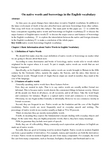
On native words and borrowings in the English vocabulary AbstractAs time goes on, great changes have taken place in native English vocabulary. In addition to the inner evolvement of itself, it has also absorbed more and more borrowings from other culture. This essay will focus on exactly this subject. The main parts in this paper are: ①to exhibit the basic conceptions regarding native words and borrowings in English vocabulary;②to discuss the major features of English native words;③to discuss the major sources and features of borrowings in the English vocabulary; ④to explore the interrelation between the native and foreign elements in the English vocabulary.⑤to make a conclusion of the whole paper.Key words native words borrowings English vocabularyChapter 1 Basic Information about Native Words in English Vocabulary1、1 Definition of Native WordsWe should first make clear the exact definition of native words or borrowings no matter what we are going to discuss about them next.According to some dictionaries and books of lexicology, native words refer to words which originated in the region where it is used. To put it simple, native words are words that are not foreign or imported.Specifically, as for English vocabulary, native words are words brought to Britain in the fifth century by the Germanic tribes, namely the angles, the Saxons, and the jutes, thus known as Anglo-Saxon words. Though words of Anglo-Saxon origin are small in number, they stand at the core of the language.1、2 Features of native wordsGenerally speaking, native words have these features below:First, they are neutral in style. That is to say, native words are usually neither formal nor informal. This is because native words denote the commonest things in human society. Almost all the people use them in all places, on all occasions, and at all times. Take the word begin and commerce for instance. Begin is a typical native word and commerce is a borrowing.Obviously, we use begin neither formally or informally. However we use commerce mostly in formal occasions.Second, they are frequent in use. Native words are the foudation and the core of the English vocabulary. Native words are most frequently used in everyday speech and writing. The percentage of native words in use reaches usually as high as 70 to 90 percent.Third, in structure they are mostly monosyllabic words.Fourth, in meaning they express the fundamental concepts dealing with everyday objects and things. At the same time, they are highly polysemic words, that is, they have many meanings.Fifth, in grammar they include most parts of speech.Sixth, they are of collocability. Many commonly-used expressions and phrases in English are made up of native words.Seventh, they are good at forming word in modern English. Native words in modern English can form a great number of derivatives. For example, watery and waterless are both the derivatives of water. Native words in modern English can also form many compounds. For example, the word fire can form many compounds, such as fireman, firefighter, fireplace and firebrand and so on.Chapter 2 Basic Information about Borrowings in English Vocabulary2.1 Definition and Main Features of BorrowingsBorrowings, or borrowed words, or loan words, refers to the words taken from foreign language.As a language which owns the most speakers, English has adopted words from almost all other major languages in the world. As is stated in Encyclopedia Americana, “the English language has vast debts. In any dictionary some 80% of the entries are borrowed”. Thus the English language is called “a heavy borrower”. Here “borrowing” is not real “borrowing”. It has nothing to with returning. It’s merely a metaphor stands for the foreign words from a different culture. But not all foreign words do become borrowings. If they fall out of use before they become widespread, they do not reach the borrowing stage.Through analyzing the borrowings in English vocabulary, we can find some common features among them.First, borrowings in English vocabulary usually do not have relative native words with the same meaning with them. When this is the case, certain concepts, ideas or objects of the “lending”language community are new to the people of the “borrowing” language community. So instead of making up a complete whole new word for the idea or object they simply borrow the word from the people they came in contact with.Second, borrowings are usually words that refer to exotic ideas, concepts or objects. An example of this is how names of animals that do not inherently come from Great Britain are often loanwords in English. The name of the animal is borrowed from the language that is spoken in the country in which the animal originally comes from or lives in.Third, most of the borrowings in English vocabulary are nouns. Nouns and lexical words in general, are borrowed more frequently than grammatical words. An example of this is the word “bagel”. The word was adopted from the Yiddish language, since the Jews were those who introduced bagels to the rest of the world. Many other languages, including English, therefore borrowed the word “bagel”.Fourth, borrowings are often even more widely known than native words since their borrowing served a certain purpose, for example to provide a name for a new invention. An example of such a borrowing is “pizza”. Since the Italians were those who introduce pizzas in England, the England borrowed the word from them.2.2 Major Sources of Borrowings in the English VocabularyTo discuss this question, we should first get to know the exact meaning of “source of borrowing”. Here it refers to the place where the borrowing was borrowed.Generally speaking, Latin, Greek and French are the three languages that have contributed most to the English language. Other foreign languages that have contributed words are of less importance.That is to say, Latin, Greek and French are the three main sources where borrowings in English vocanulary come from. Apart from the three, Scandinavian, Celtic, Dutch, Low German, Arabic, Persian, Portuguese, Spanish are also the main sources of borrowings in English vocabulary. Some examples of borrowings in English voabulary are as follows.Among those borrowings that come from the Germanic are the words father, mother, brother, man, wife, tree, grass, summer, winter, bring, come, get, hear, meet, and think and so on.Such words as constitution, president, parliament, congress, city, place, , diner, café, liberty, veracity, carpenter, draper, haberdasher, mason, painter, plumber, and tailor are from France.English has acquired many words from Spanish. Some of these have been borrowed directly: cigar, armada, guerrilla, matador, mosquito, and tornado.Borrowings from Latin have been especially numerous. Many of these represent combinations of Latin words: alnutrition, transfer, circumference, supernatural, submarine, suburb, substantial, contemporary, multilingual, conjunction, compassion, and hundreds more.Borrowings from Greek are heavy in the sciences and technology. In addition to macro and micro, often-used prefixes include poly and tele. Among the well-known English words from Greek are alphabet, geometry, geology, photography, psychology, pathology, biology, philosophy, telephone, logistics, and metamorphosis.Among the common English words that have come from Arabic are: alcohol, alchemy, algebra, alkali, almanac, arsenal, assassin, cipher, elixir, mosque, naphtha, sugar, syrup, zenith, and zero.Borrowings in English vocabulary are so numerous that they can not be listed one by one The above are the language sources that English vocabulary comes from. Below are the specific sources or we’d better say specific channels that borrowings come from. Generally speaking, English vocabulary mainly comes through conquest, commerce, travel, literature, mass media or some other ways. In other words, those borrowings have come into English vocabulary through the spoken word, on one hand, and through the written word, on the other hand.Chapter 3 The Interrelation between the Native and Foreign Elements in the English VocabularyIn fact, no language has so complex and varied a vocabulary as English. The English vocabulary has been adopted from more than fifty languages. As a cosmopolitan language English has no rival. That is to say, up to seventy percent of the English vocabulary consists of loan-words, and only thirty percent are native words.In spite of large-scale borrowings, it is the native words that form the basic stock of modern English vocabulary. And what’s more, native words are used in everyday speech and writing more frequently than borrowed words.Generally, the longer a borrowed word has been in the language, and the more frequently it is used, the more it resembles the native words of the language.In the course of historical development borrowed words have extended the total number of the English vocabulary, and Latin or Greek roots, prefixes or suffixes have changed the structures of English words.Chapter 4 conclusionTo sum up, we can say that English vocabulary has been marked by the word ‘borrowing’. Since early times, English has been in contact with other languages such as Greek, French, Scandinavian, Celtic, Dutch, Low German, Arabic, Persian, Portuguese, and Spanish and so on, and as a result, English vocabulary has been riched under the influence of other languages. It is native words and borrowings together help strengthen the English vocabulary and make it a very open and the most poewrful language in the modern world.Bibliography参考书目??/~kemmer/Words04/structure/borrowed.htmlhttp://www1.ku-eichstaett.de/SLF/EngluVglSW/grzega1032.pdfhttp://dooku.miun.se/engelska/englishC/C-essay/VT06/Final/NicoleFerm.pdf/~kemmer/Words/loanwords.html/media_file/200708/huashi/0809/cihuix/web/unit02.htm。
英语词汇学硕士论文范文
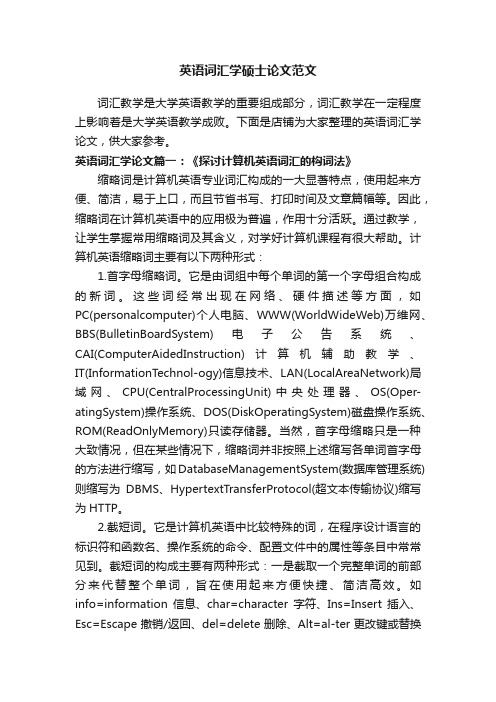
英语词汇学硕士论文范文词汇教学是大学英语教学的重要组成部分,词汇教学在一定程度上影响着是大学英语教学成败。
下面是店铺为大家整理的英语词汇学论文,供大家参考。
英语词汇学论文篇一:《探讨计算机英语词汇的构词法》缩略词是计算机英语专业词汇构成的一大显著特点,使用起来方便、简洁,易于上口,而且节省书写、打印时间及文章篇幅等。
因此,缩略词在计算机英语中的应用极为普遍,作用十分活跃。
通过教学,让学生掌握常用缩略词及其含义,对学好计算机课程有很大帮助。
计算机英语缩略词主要有以下两种形式:1.首字母缩略词。
它是由词组中每个单词的第一个字母组合构成的新词。
这些词经常出现在网络、硬件描述等方面,如PC(personalcomputer)个人电脑、WWW(WorldWideWeb)万维网、BBS(BulletinBoardSystem)电子公告系统、CAI(ComputerAidedInstruction)计算机辅助教学、IT(InformationTechnol-ogy)信息技术、LAN(LocalAreaNetwork)局域网、CPU(CentralProcessingUnit)中央处理器、OS(Oper-atingSystem)操作系统、DOS(DiskOperatingSystem)磁盘操作系统、ROM(ReadOnlyMemory)只读存储器。
当然,首字母缩略只是一种大致情况,但在某些情况下,缩略词并非按照上述缩写各单词首字母的方法进行缩写,如DatabaseManagementSystem(数据库管理系统)则缩写为DBMS、HypertextTransferProtocol(超文本传输协议)缩写为HTTP。
2.截短词。
它是计算机英语中比较特殊的词,在程序设计语言的标识符和函数名、操作系统的命令、配置文件中的属性等条目中常常见到。
截短词的构成主要有两种形式:一是截取一个完整单词的前部分来代替整个单词,旨在使用起来方便快捷、简洁高效。
实用词汇学论文
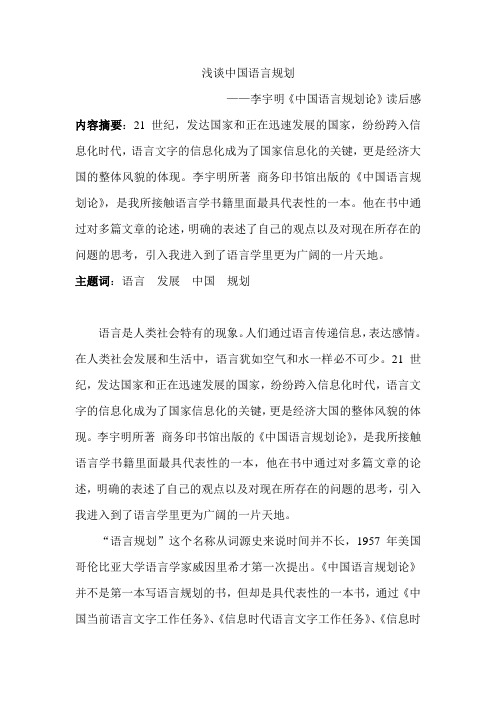
浅谈中国语言规划——李宇明《中国语言规划论》读后感内容摘要:21世纪,发达国家和正在迅速发展的国家,纷纷跨入信息化时代,语言文字的信息化成为了国家信息化的关键,更是经济大国的整体风貌的体现。
李宇明所著商务印书馆出版的《中国语言规划论》,是我所接触语言学书籍里面最具代表性的一本。
他在书中通过对多篇文章的论述,明确的表述了自己的观点以及对现在所存在的问题的思考,引入我进入到了语言学里更为广阔的一片天地。
主题词:语言发展中国规划语言是人类社会特有的现象。
人们通过语言传递信息,表达感情。
在人类社会发展和生活中,语言犹如空气和水一样必不可少。
21世纪,发达国家和正在迅速发展的国家,纷纷跨入信息化时代,语言文字的信息化成为了国家信息化的关键,更是经济大国的整体风貌的体现。
李宇明所著商务印书馆出版的《中国语言规划论》,是我所接触语言学书籍里面最具代表性的一本,他在书中通过对多篇文章的论述,明确的表述了自己的观点以及对现在所存在的问题的思考,引入我进入到了语言学里更为广阔的一片天地。
“语言规划”这个名称从词源史来说时间并不长,1957年美国哥伦比亚大学语言学家威因里希才第一次提出。
《中国语言规划论》并不是第一本写语言规划的书,但却是具代表性的一本书,通过《中国当前语言文字工作任务》、《信息时代语言文字工作任务》、《信息时代的中国语言问题》《语言学发展的新机遇》、《信息时代需要更高水平的语言文字规范》等多篇文章的论述,清楚的描述了自己的见解并阐述了时代赋予我国语言文字工作者的神圣使命。
同时他的文章是站到时代高端去审视国家的语言问题。
更值得我深深地了解到真谛。
1《中国语言规划论》的内容特点1.1站位高,展现强烈的时代气息,这是《中国语言规划论》一书的一个重要特点。
中国正在向经济大国阔步迈进,中国的语言文字工作者必须站到时代潮头,与时俱进的思考自己的工作如何让才能跟历史车轮同进。
一些“传统任务”的完成,比如普通话的推广、现行汉字的整理和汉语拼音方案的推行,也应提升到信息化的高度来统筹规划。
实用英语词汇学
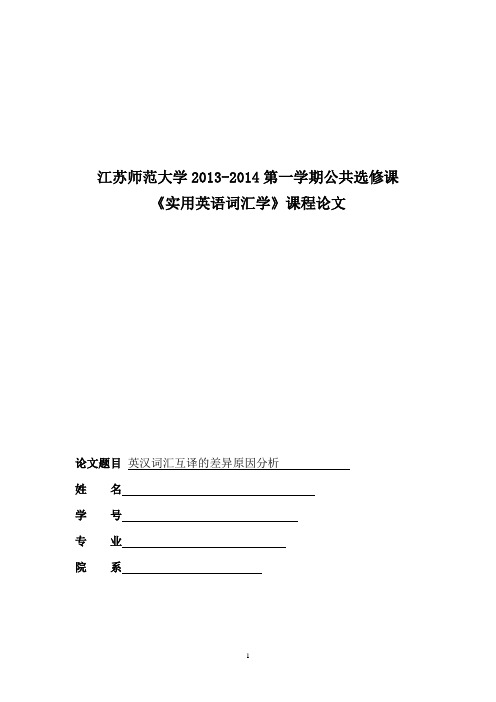
江苏师范大学2013-2014第一学期公共选修课《实用英语词汇学》课程论文论文题目英汉词汇互译的差异原因分析姓名学号专业院系摘要:英汉互译是很多人希望可以熟练掌握的一门技巧,可是汉英互译的差异,即英语倾向于音译,而汉语倾向于意译的原因,使得很多人不能得其要领而在门外徘徊。
本文在对这些研究进行回顾和总结的基础上,尝试从语言文化和文化传统两个方面分析。
关键词:英汉互译;差异;语言;文化。
1、引言词汇是语言的三大要素之一,在语言学习中起着重要作用。
英国语言学家威尔斯金曾说过:“没有语法,人们表达的事物寥寥无几,而没有词汇,人们则无法表达任何事物。
”词汇在语言中占有如此重要的地位,因此学好词汇背诵词汇具有重要意义。
所有英语的学习者都清楚,学好英语必须学习大量的词汇。
但面对如此多的生词时,我们时常感到困惑、烦躁,尤其是汉英互译时大体意思的差异,使得背诵英语难上加难。
所以,本文将探讨英语的英汉互译的差异原因,期望从中能找到学习英语词汇的突破口。
本文主要从英语词汇学的角度,采用比较分析法和语篇中的意思语境背理论来研究英汉词汇互译。
本文将通过对大量词语的分析、研究来论述英汉互译差异产生的原因、背景,在此基础上并试图发现词汇互译的特点。
本文期望能具有一定的实用价值,使英语学习者对英汉互译有比较清晰的认识,同时能激发英语学习者学习英语词汇的兴趣,帮助其有效扩大词汇量,灵活掌握英语词汇。
2、文献回顾作为一种语法现象,英汉互译引起了众多语法学家的关注。
本文拟从三个章节研究英语词汇及词汇互译。
论文第一二章主要介绍语言制约这个极其重要的原因,其中包括表音文字和表意文字、分析性语言和综合性语言这两大方面的原因。
接下来第三章是文化方面的差异分析。
第一章语言制约——表音文字和表意文字英语是表音文字(phonetic writing).其字母和音素是对应的。
语言中所有的音节最后都能分解为音素,用一定的字母或字母组合在书写形式上表示,如magazine听到的3个音节,分析为8个音素分别用8个字母表示,组合起来就成了magazine。
- 1、下载文档前请自行甄别文档内容的完整性,平台不提供额外的编辑、内容补充、找答案等附加服务。
- 2、"仅部分预览"的文档,不可在线预览部分如存在完整性等问题,可反馈申请退款(可完整预览的文档不适用该条件!)。
- 3、如文档侵犯您的权益,请联系客服反馈,我们会尽快为您处理(人工客服工作时间:9:00-18:30)。
浅谈中国语言规划
——李宇明《中国语言规划论》读后感内容摘要:21世纪,发达国家和正在迅速发展的国家,纷纷跨入信息化时代,语言文字的信息化成为了国家信息化的关键,更是经济大国的整体风貌的体现。
李宇明所著商务印书馆出版的《中国语言规划论》,是我所接触语言学书籍里面最具代表性的一本。
他在书中通过对多篇文章的论述,明确的表述了自己的观点以及对现在所存在的问题的思考,引入我进入到了语言学里更为广阔的一片天地。
主题词:语言发展中国规划
语言是人类社会特有的现象。
人们通过语言传递信息,表达感情。
在人类社会发展和生活中,语言犹如空气和水一样必不可少。
21世纪,发达国家和正在迅速发展的国家,纷纷跨入信息化时代,语言文字的信息化成为了国家信息化的关键,更是经济大国的整体风貌的体现。
李宇明所著商务印书馆出版的《中国语言规划论》,是我所接触语言学书籍里面最具代表性的一本,他在书中通过对多篇文章的论述,明确的表述了自己的观点以及对现在所存在的问题的思考,引入我进入到了语言学里更为广阔的一片天地。
“语言规划”这个名称从词源史来说时间并不长,1957年美国哥伦比亚大学语言学家威因里希才第一次提出。
《中国语言规划论》并不是第一本写语言规划的书,但却是具代表性的一本书,通过《中国当前语言文字工作任务》、《信息时代语言文字工作任务》、《信息时
代的中国语言问题》《语言学发展的新机遇》、《信息时代需要更高水平的语言文字规范》等多篇文章的论述,清楚的描述了自己的见解并阐述了时代赋予我国语言文字工作者的神圣使命。
同时他的文章是站到时代高端去审视国家的语言问题。
更值得我深深地了解到真谛。
1《中国语言规划论》的内容特点
1.1站位高,展现强烈的时代气息,这是《中国语言规划论》一书的一个重要特点。
中国正在向经济大国阔步迈进,中国的语言文字工作者必须站到时代潮头,与时俱进的思考自己的工作如何让才能跟历史车轮同进。
一些“传统任务”的完成,比如普通话的推广、现行汉字的整理和汉语拼音方案的推行,也应提升到信息化的高度来统筹规划。
1.2有思路,明确提出自己意见,这是《中国语言规划论》一书的又一个重要特点。
《我国的语言生活问题》一文提出四个思路:其一,促使汉语成为国际强势语言;其二,争取汉语在虚拟世界里的地位;其三,处理好外语与母语的关系;其四,保护濒危语言。
《通过语言文字规范标准的建设》的一文提出三个思路:其一,建设规范标准的理想体系;其二,建立科学的运作机制;其三,处理好刚与柔、学理与俗实、制定与维护、科学性与时效性等关系。
诸如此类的论说,不可能全是创新,却表明了作者很有主见。
1.3讲品味,重视学术层面的探讨,这是《中国语言规划论》一书的再一个重要特点。
本书中的文章,或者偏重于讲工作,或者偏重于谈学术,或者甲中有乙、乙中有甲,但总体上都反映出了提高学术品位的美学理念。
但最能说明问题的文章之一,也许就是《论母语》。
文章指出:母语是个民族领域的概念,反映的是个人或民族成员对民族语言和民族文化的认同。
母语直接指向民族共同语,但不指向共同语的地域变体,方言只能成为母言,不能视为母语;第一语言是人们“思维和交际的自然工具”,即所谓“自我表达的天然工具”,但与母语不是等同的概念。
对于单一语言群体的母语问题,双语社会和双语家庭的母语问题,“母语失却”问题,文章从不听侧面展开了论说,其内容既是搞好语言文字工作的需要,其分析又同时反映出了讲求科学性的学术严谨。
2从《中国语言规划论》看当前中国的语言生活
2.1当前中国的语言生活的特点
根据书上所讲述的,我了解到,中国当今的语言生活总起来可以概括为16个字:生机勃勃,多姿多彩,矛盾交织、鱼龙混杂。
所谓生机勃勃,多姿多彩,突出表现在新的语言现象、新的使用方式和新的使用风格上;所谓矛盾交织、鱼龙混杂,是说新的语言生活带来了许多新的矛盾和问题。
但这些评价未必能让人接受,毕竟这种评价方面从来没有客观的标准。
2.1.1新的语言现象大量涌现。
词汇是语言感知社会最敏锐的触角,社会的细微变化都会首先被词汇系统感知。
近几年中国的巨大变化,带来了许多新鲜的事物和新潮的思想,从而把中国的语言生活推向了一个前所未有的开放状态,新词新语接踵涌现,词语的新意思新
用法令人目不暇接。
2.1.2大量“超规范”现象步入大众传媒。
T恤、卡拉OK和应接不暇的传统与外来组合的词语,如今文字方面基本处于繁体字、简体字、二简字等并存的局面。
这些外来语直接进入汉语交际圈。
2.1.3南方有影响的方言向北方“挺进”在影视界,方言也向普通话发起了攻势局面,一些地方性特色很浓的电视剧干脆制作出了方言、普通话两个版本。
由于当前特定的社会环境,这些现象再度复苏,并已为一些知识阶层所接受,在某种意义上可以说具有积极地作用。
2.2当前中国的语言生活的特点引发的思考
2.2.1对语言规范化的理解
当前中国语言生活的现状给我们带来不少思考。
其中最大的问题是到底什么是语文规范化。
吕冀平有一段话:语文规范化是一项涉及许多方面的系统工程,除国家有关机构中的管理人员外,语文工作者、教育工作者,特别是各种传媒工作者,对此都肩负着重要的任务。
任务中应该强调一项,我觉得就是根据语言规范的科学理论去引导语言的约定俗成。
实际上是在向我们表明,语言内部的规律永远在左右着语言的发展。
语言研究应该探讨语言的这种内部机构,而这恰恰是过去注意不够的地方。
2.2.2语言规范化与语言现代化
人们在追求现代化生活的同时,也必然追求语言生活的现代化。
于是就有了“语文现代化”的口号。
规范化和现代化的关系十分密切。
没有规范化,语言使用上一盘散沙,很难说是现代化的标志。
而另一方面,如果人们不追求语言生活的现代化,就会影响社会的正常交往。
2.2.3规范的层次性
社会各个集团对语言的运用的要求是不一样的。
因此,我们觉得规范的正确是应该有层次的,这有点像数学上的近似数。
优势我们可以采用他们的精确值,有时则可以取其近似值。
所谓“南腔北调”的普通话或曰过渡性普通话就可以看作是这样的一种东西,想必这应该是个很有时间价值的概念
2.2.4规范的目标
规范只能是一个总体目标。
它带有浓厚的理想化色彩。
语音如此、词汇如此、语法也如此。
规范有一个过程,人们对规范的认识也有一个过程,在确定规范目标时,我们要考虑到语言应用观对语言生活的影响。
我认为,进行一次语言应用观的调查和分析,对于我们认识语言的规范性、确立新时期语言规范目标,具有重要意义。
从上面分析可以看出,目前中国语言生活的状况是有多重因素集结而成的。
中国语言规划,从制定到实施,到获得良好结果,需要一辈接一辈众多有志之士、有识之士、有为之士,做出坚持不懈的努力。
我想年轻的我们应该自觉承担历史重任,把握学术机遇,用自己的努力为我国的语言学事业尽微薄之力。
参考文献
[1]胡明扬1983 《语言与语言学》,湖北教育出版社
[2]郭熙1999 《中国社会语言学》,南京大学出版社
[3]吕冀平2000 《当前我国语言文字的规范化问题》,上海教育出版社。
